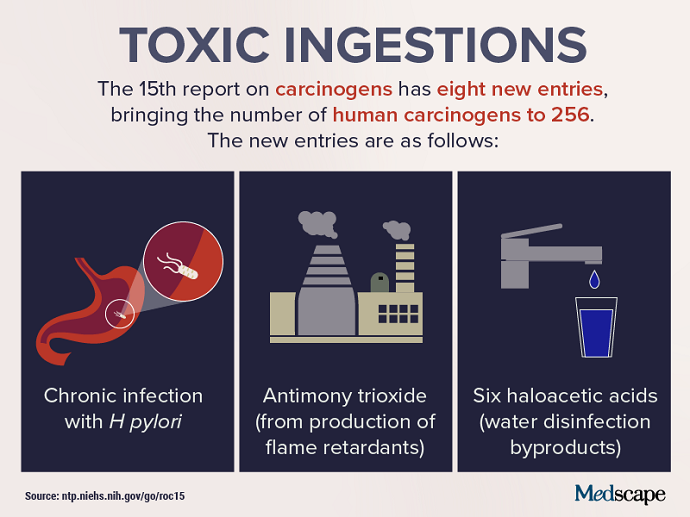Each week, we identify one top search term, speculate about what caused its popularity, and provide an infographic on a related condition. If you have thoughts about what's trending and why, share them with us on Twitter or Facebook.
The National Toxicology Program for the Department of Health and Human Services recently released the 15th report on carcinogens (see Infographic). Elsewhere, news emerged about shocking, population-wide consequences of lead poisoning. These and other developments resulted in this week's top trending clinical topic.
The first report, released in 1980, included just 26 carcinogens. Experts suggest that the list still probably understates the number of carcinogens to which humans are exposed. In the past, some substances originally included were "delisted" after litigation or new research. For example, saccharin was listed as "reasonably anticipated" to cause cancer in 1981 but was then removed from the ninth edition, after extensive review determined that data were insufficient to meet criteria. Other entries remain controversial. Tamoxifen, originally listed in the ninth report (and still included in the 15th report), was added because studies found that it could increase the risk for uterine cancer in women. However, conclusive evidence also found that it may prevent or delay breast cancer in women at high risk.
In terms of other toxic concerns, researchers investigating chemicals in cosmetic products found high fluorine levels in many that they tested. This indicates the probable presence of PFAS, which are per- and polyfluoroalkyl substances. For the study, published online in Environmental Science & Technology Letters, Bruton and colleagues screened 231 cosmetic products purchased from such retailers as Ulta Beauty, Sephora, Target, and Bed Bath & Beyond for fluorine. Three quarters of waterproof mascara samples had high fluorine concentrations, as did nearly two thirds of foundations and liquid lipsticks and more than half of the eye and lip products tested. Many of these chemicals were not included on the product labels, making it difficult for consumers to consciously avoid them.
In terms of consequences related to other toxic ingestions, a recent study found that half of US adults were exposed to harmful lead levels as children. More than 170 million Americans were exposed to harmful levels of lead, and 90% of those born between 1951 and 1980 had blood lead levels higher than the threshold set by the Centers for Disease Control and Prevention. On average, this lead exposure resulted in a 2.6-point drop in IQ per person. Taken altogether, that's more than 800 million IQ points.
In reviewing the data, F. Perry Wilson, MD, MSCE, states that "[f]rom 1960 to 1980, virtually every single child in the US would have had lead levels in their blood that today we consider toxic." Wilson concludes that the main takeaway from the study isn't a call for specific action against toxic ingestion of lead, but "a reminder that the impact of the environment — on how we organize industry and society — on our health may not be fully understood for decades."
From current carcinogen concerns to modern measurement of a historical problem, news about toxic ingestion seized much attention this week, resulting in the top trending clinical topic.
Learn more about lead toxicity.
Medscape © 2022 WebMD, LLC
Any views expressed above are the author's own and do not necessarily reflect the views of WebMD or Medscape.
Cite this: Ryan Syrek. Trending Clinical Topic: Toxic Ingestions - Medscape - Mar 18, 2022.











Comments